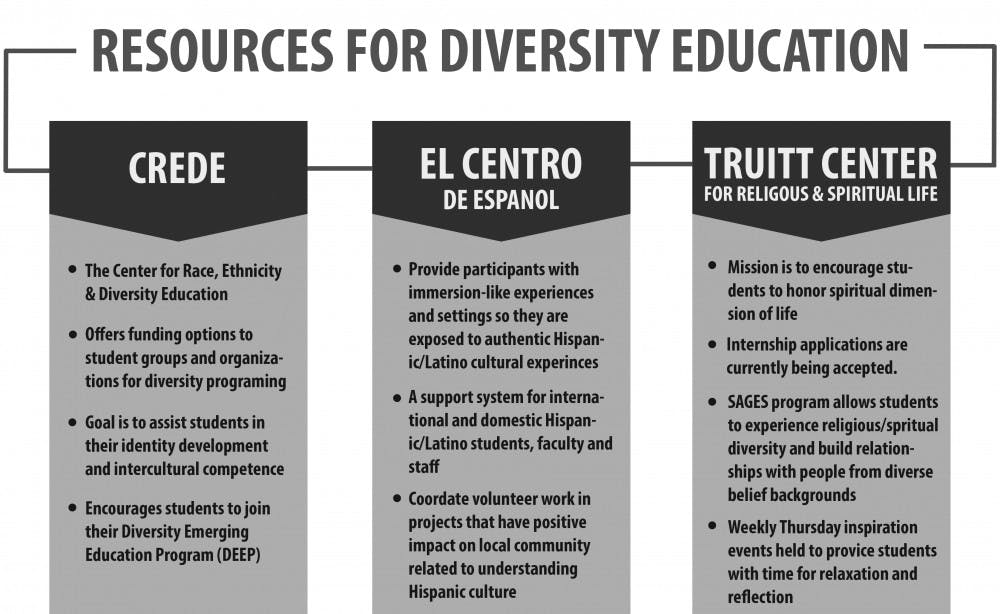Freshman Jazmine Langley knew what she was getting into when she applied to Elon University last year.
As an African-American student wishing to attend a predominantly white institution, she understood that she would be in the minority. But one weekend visit instilled a sense of belonging in her — something other applicants may never experience.
“I feel like Phoenix Fusion either makes or breaks your decision about coming to Elon,” Langley said. “I toured Elon before coming to Phoenix Fusion, but then I came and was exposed to a lot of resources to marginalized groups that I didn’t know beforehand. That was a really big help for me.”
Phoenix Fusion, a two-day admissions event geared toward minority students, was the deciding factor for Langley. During the weekend, she spent the night on campus with an enrolled student and saw resources like The Center for Race, Ethnicity and Diversity Education (CREDE) that gave her confidence about the next four years. But because the regular tour didn’t show her this side of Elon, she said she believes the university can do a better job of marketing itself toward minority students who may not visit a second time — or even a first time — like she did.
“Seeing firsthand that the minority population has a presence here was definitely the biggest thing for me,” Langley said. “I think just letting people know about the resources available to them before they get to college and while they are here to sustain themselves can be improved on.”
Since 2010, Elon’s ALANAM (African American/Black, Latino/Hispanic, Asian Pacific Islander, Native American, Alaskan Native and Multiracial) population has increased from 12.4 percent to 15.8 percent. But the 6 percent African-American student population falls slightly behind similar schools in the state, such as Davidson College (8 percent) and High Point University (7.4 percent).
These statistics may make prospective students weary of attending Elon because they might not fit the mold. ALANAM students are also proven to have a higher application incompletion rate compared to other students.
Greg Zaiser, vice president of Admissions and Financial Planning, says the university recognizes this problem and is working to make Elon palatable to minorities. He says one of the main ways to solve this is utilizing Pillar One of the Elon Strategic Commitment Plan, a system to promote diversity that includes objectives of doubling the need based financial aid and preparing students to succeed in a multicultural world.
“Everything we do at the university is driven by this plan because we believe an excellent education must include diversity,” Zaiser said. “In partnership with the university community, the entire admissions staff implements the plan.”
Part of this plan is creating and using spaces like the CREDE, El Centro de Espanol and the Truitt Center for Religious Life to demonstrate the need for an inclusive community. Diversity Ambassadors — student university guides who support the Office of Admissions with diversity recruitment by offering feedback and support — are also great assets.
Jamie Butler, assistant director of the CREDE, said all of these things are needed to genuinely portray that Elon cares about its minority population and wants to seem more attractive to diverse groups. She also added that organizations like the Black Student Union and Elon Black Alumni Network are avenues students should use when needing support and guidance.
“I would say that there is definitely a support system in place,” Butler said. “I do see that there is a need for different welcoming and support and advocacy for students underrepresented at Elon and that piece that is not needed for the majority.”
Zaiser said the applicant pool is becoming more diverse each year and his office is intentionally reaching out to high schools and intends to expand its diversity recruitment staff within the year. But when these students arrive on campus, they are culture shocked.
With many of the students Butler speaks to, she finds that they have a hard time assimilating to Elon’s environment because many feel that they have to prove to themselves and others that they belong. She said while the university has and continues to improve in attaining more diversity, it is up to white students to make minorities adjustments to a new environment as seamlessly as possible.
“I would defiantly tell [white students] to validate other students’ experiences,” Butler said. “Don’t be dismissive and don’t make up other reasons [for minority students struggling to fit it]. It’s tough enough here to be a student here at Elon, its tougher to be a student here of color whether we want to admit it or not. I think that particularly with [white students], understanding that, validating that and accepting that is huge.”


